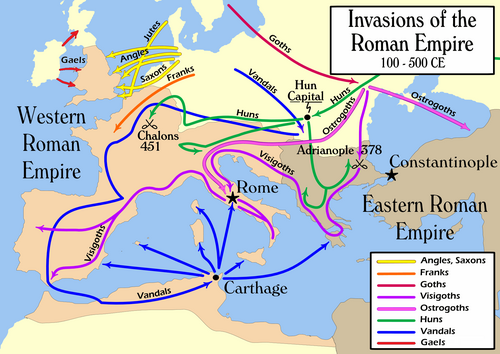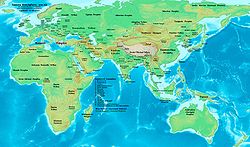Migration period
The migration period, or barbarian invasions or Völkerwanderung happened in 300–700 AD in Europe,[1][2] at the end of ancient history and during the Early Middle Ages.

The migrations included the Goths, Vandals, Franks, and other Germanic tribes; the Bulgars; and Slavic tribes.[3] They may have been influenced by attacks of the Huns in the East and may also be connected to the Turkic migrations in Central Asia, overpopulation, or climate change. The migration period also included groups of Angles, Saxons, Frisians, and some Jutes to Britain.[4]
The migrations would continue well into the Middle Ages, beyond 1000 AD, with successive waves of Slavs, Roma, Avars, Bulgars, Hungarians, Pechenegs, Cumans, and Tatars, which changed the ethnic makeup of Eastern Europe.[5] Historians in Western Europe, however, tend to stress the migrations that were most relevant to that area.
Migration Period Media
A Migration Period Germanic gold bracteate depicting a bird, horse, and stylized human head with a Suebian knot
Migration of early Slavs in Europe in the 6th–7th centuries
Migration and settlement of the Bulgars during the 6th–7th centuries AD
Slavic fibula brooch made of copper dating back to the Migration Period, c. 600–650 AD
Barbarian kingdoms and peoples after the end of the Western Roman Empire in 476 AD
Related pages
References
- ↑ Precise dates given may vary; ones that are often cited are 410, the sack of Rome by Alaric I, or 751, the accession of Pepin the Short and the establishment of the Carolingian dynasty.
- ↑ Climate change and human mobility: challenges to the social sciences, eds. Kirsten Hastrup, Karen Fog Olwig (Cambridge; New York: Cambridge University Press, 2012), p. 29.
- ↑ John Bagnell Bury, A History of the Later Roman Empire: From Arcadius to Irene (395 A.D. to 800 A.D.) (London; New York: Macmillan and Company, 1889), p. 31
- ↑ Peter Hunter Blair; Simon Keynes, An Introduction to Anglo-Saxon England (Cambridge: Cambridge University Press, 2003), p. 10
- ↑ Lucy Mallows, Transylvania (Chalfont St. Peter: Bradt Travel Guides, 2008), p. 18
Other websites
- J.B. Bury (1923). History of the Later Roman Empire







